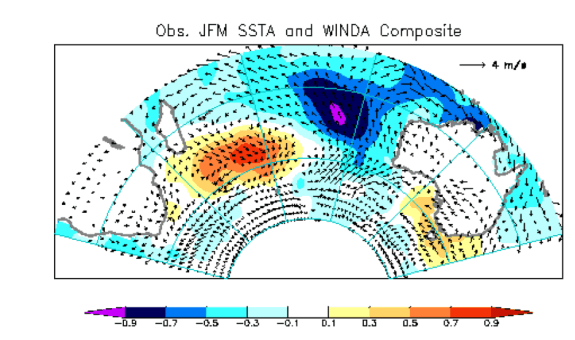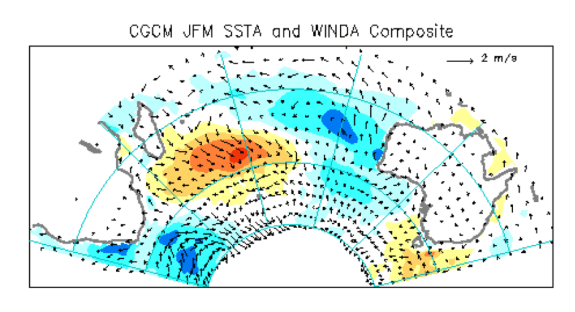Indian Ocean Subtropical Dipole (IOSD)

Dipole events evolve in the subtropical southern Indian Ocean region during the austral summer (Behera and Yamagata 2001).
Those are found to be linked with the strengthening or weakening of the Mascarene High. In a positive dipole event, which is associated with above normal rainfall in parts of southern Africa and Australia, the subtropical high is strengthened along with the strengthening and west ward shift of the west coast trough observed in the western Australia. The resultant stronger than normal winds off the coast of Australia cause cooling of SST in the southeastern part mainly through the enhanced evaporation. On the other hand reduced evaporation due to reduced wind speed allows increased influx from the atmosphere thus warming the southwestern part. Ekman transport along with surface mixing processes also help the formation of SST dipole.

The Indian Ocean subtropical dipole (IOSD) is remarkably well simulated in a coupled ocean-atmosphere general circulation model (Suzuki et al. 2004).
The increased moisture advection from the southeastern part by the stronger easterlies then helps in the enhanced convective activity over southern Africa (Reason,. 2006). The local and remote responses of the rainfall anomalies to the subtropical dipole pattern is investigated using the standalone atmospheric GCMs (Reason 2001; 2002). Terray et al. (2003) suggested that the IOSD related anomalies over the SEIO are highly persistent and affect the position of the Mascarene High and the subsequent Indian summer monsoon. When the amplitude of SSTA in the southern Indian Ocean is large enough, SSTA in the southern Indian Ocean can play an important role in controlling rainfall, which is evident in the late 1980s (Wang et al. 2006). Several paper discussed the IOSD impact on regional and global climate variabilities (e.g. Reason et al. 2005; Mapande and Reason 2005a, 2005b; Jia and Li 2005; England et al. 2005; Reason, 2006; Ash et al. 2012)
The subtropical dipole mode in the Indian Ocean is generally found to accompany similar dipole mode events in the subtropical southern Atlantic (e.g. Venegas et al. 1997; Fauchereau et al. 2003; Hermes and Reason 2004) and Pacific Oceans.
The IOSD is also shown to affect the seasonal ocean-atmosphere gas exchanges in the southern Indian Ocean; results from field experiments suggest that warm anomalies related to IOSD in the western Indian Ocean are responsible for reducing the oceanic carbon dioxide uptake (Jabaud-Jan et al. 2004).
If you have recently published an article related to this topic, please send me the citation of your manuscript. I will include it in the list of references and add a few lines about your work here.